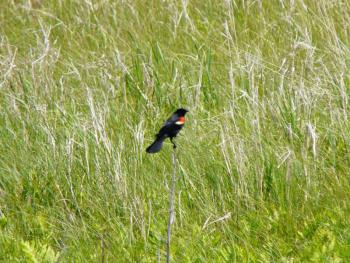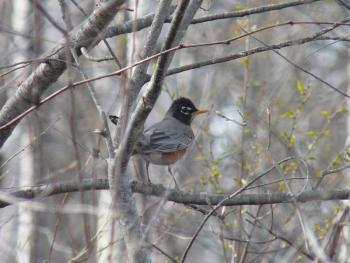It began on March 1, with a posting on the Maine Birding list-serv of a Red-Winged Blackbird observed in Freeport, not surprisingly at the well-stocked array of feeders of my good friends at Freeport Wild Bird Supply. There had been one or two previous postings of blackbird sightings, but this bird was only 70 miles away. This harbinger of spring was moving up the coast! Despite the seeming absurdity of spring birds arriving as we continue to endure snowstorms interspersed with days of snow flurries, I immediately alerted my mother to be on the lookout at her feeders along the Megunticook River: blackbirds are on their way!
The robin has often been regarded as the quintessential symbol of spring, but truth of the matter is, they’ve been around all winter. These hardy thrushes flock up and travel from crabapple tree to berry bush, seeking whatever fruits remain to sustain themselves. In February on Beech Hill in Rockport, a friend and I encountered a flock of nearly 50 robins feeding in the sumacs, then moving down onto patches of the blueberry barrens that had been swept bare by winds, apparently finding grubs and other treats there. As we hiked down the hill, the flock flew past us in small groups, heading for dead leaves exposed around the trailhead kiosk and along the stone walls that border the road. Pickings there probably included half-frozen caterpillars.
These robins most likely weren’t “our” robins — the birds that we see pulling worms in our yards and whose rollicking songs wake us up on spring mornings — but rather, northern robins, which had shifted south for the winter. They were now working their way back to their breeding grounds. Our local robins appear in numbers as the ground thaws in late March-early April, arriving in flocks that fill the muddy fields, and then separating off to territories in our yards and wooded edges. When you hear them singing, you’ll know they’re really here to stay for the summer.
The Red-winged Blackbird may be a bit more prosaic than the ruddy-breasted robin, but at this point, I’ll grasp at any sign that spring is here. Even noticing in early March that the goldfinches at my feeders seemed to be showing more yellow plumage — bright against the falling snow — was a small thrill. (Interestingly, this yellow plumage is not comprised of fresh, new feathers, but has been under there all along, revealed now when the duller ends of its winter plumage begin to wear off.)
Herb Wilson, of Colby College’s Department of Biology, has been conducting an “Arrival Project” for years, in which he asks observers to note when they first see a species return to their area in spring. I’ve been participating in this citizen science project for a while now and have found that it has sharpened my awareness as to who’s back when. Last year, the first blackbird in our biophysical region (#14, encompassing Penobscot Bay) was noted on March 11. Another bird I closely associate with the imminent arrival of spring, the Turkey Vulture, arrived on March 7 last year (I believe that was my own observation that pegged that date into the data; I recall my surprise at seeing one in the neighborhood so early in the month). Eastern Phoebe was first noted on March 20. An interesting triad of harbingers: blackbird, vulture, and phoebe. Spring isn’t all flowers and bluebirds!
I expected to see my first vulture in early March, despite the persistence of crusty snow cover. The Turkey Vulture has slowly advanced its habitation of Maine in the past few decades, and each year seems to migrate later in the fall and return earlier in the spring. Several sightings have already been reported in southern Maine over I-95, where the birds are undoubtedly keeping an eye out for road kill.
A Turkey Vulture will only eat dead meat; its bill isn’t structured to kill prey. I’ve heard of some vulture enthusiasts putting out meat scraps in an effort to attract these large raptors. Makes for a different sort of bird feeder, but no doubt an interesting one as long as the neighbors don’t complain about the smell. While the bird isn’t the most attractive of yard visitors— looking very similar to the gaumy Wild Turkey when standing around (hence its name) — it is one of my favorite birds in flight, soaring high on broad wings in wide, lazy circles on the slightest currents of air.
While an early vulture should be able to get by on road kill and the occasional winter-starved deer carcass found in the woods, the phoebe takes a bigger risk by arriving early because this flycatcher only eats insects. You won’t see a phoebe at your bird feeder. And other than snow fleas, there aren’t a lot of insects around right now. However, a phoebe will hang out near open streams and feed on hatching stoneflies, which can apparently hatch out as early as February. So if the early-arriving phoebe can find enough stoneflies and not freeze to death, soon enough (though perhaps too soon for us) the spring air will be full of plenty of other insects for it to feed on.
Yes, alas, the arrival of many of our spring songbirds coincides with the arrival of insects—but don’t curse those black flies too much. Without them and all the other bugs that emerge as warmth returns to this part of the world, our woods and fields would be empty of graceful swallows and colorful warblers in April and May. We’d be left with robins and woodcocks (another early arrival) tugging at worms and a sky full of circling vultures.
Kristen Lindquist is an amateur naturalist and published poet who works for Coastal Mountains Land Trust in her hometown of Camden.
More Meditations
Meditations on flying squirrels
Spring peepers in autumn: Why are they still talking
Fall migration on Monhegan and the Yellow-rumped Warbler
Meditations on chasing rare birds



























